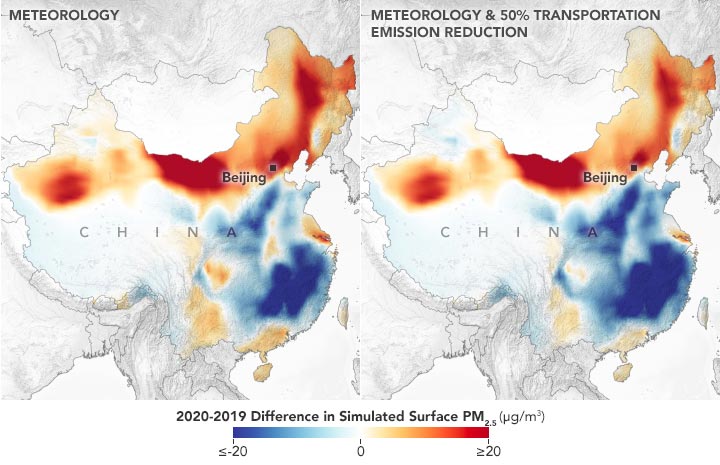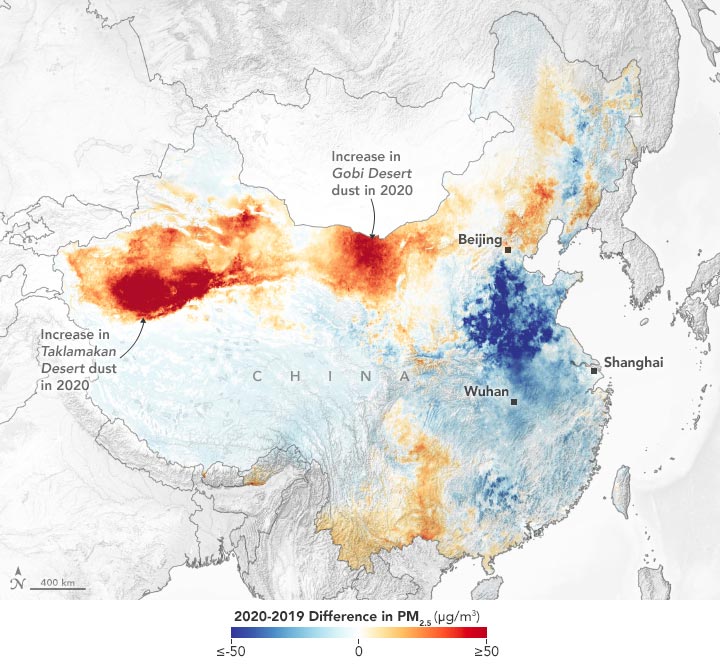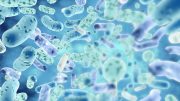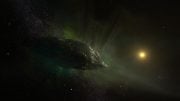Early in the COVID-19 pandemic, it became clear from satellite observations and human experience that the world’s air grew cleaner. But new research shows that not all pollutants were taken out of circulation during societal lockdowns. In particular, the concentration of tiny airborne pollution particles known as PM2.5 did not change that much because natural variability in weather patterns dominated and mostly obscured the reduction from human activity.
“Intuitively you would think that if there is a major lockdown situation, we would see dramatic changes, but we didn’t,” said Melanie Hammer, a visiting research associate at Washington University in St. Louis and leader of the study. “It was kind of a surprise that the effects on PM2.5 were modest.”
PM2.5 describes particles, produced by both human activities and natural processes, that are smaller than 2.5 micrometers, or roughly 30 times smaller than the width of a human hair. PM2.5 is small enough to linger in the atmosphere and, when inhaled, is associated with an increased risk of heart attack, cancer, asthma, and a host of other human health effects. “We were most interested in looking at changes in PM2.5 because it is the leading environmental risk factor for premature mortality globally,” Hammer said.
By combining NASA spacecraft data with ground-based monitoring and an innovative computer modeling system, the scientists mapped PM2.5 levels across China, Europe, and North America during the early months of the pandemic. They found seasonal differences in PM 2.5 between recent years were driven primarily by the natural variability of the meteorology, not by pandemic lockdowns. Some of the meteorological effects included changes in the sources and intensity of seasonal dust storms, the way pollutants reacted to sunlight in the atmosphere, the mixing and transfer of heat via weather fronts, and the removal of pollutants from the atmosphere by falling rain and snow.
One example is shown on the map above, which compares PM2.5 levels across China in February 2020 versus February 2019. Note that although pollution levels dropped significantly in some of the most industrialized parts of China, they were actually higher near China’s desert regions. The pollution mapping effort included data from NASA’s Terra and Aqua satellites, as well as meteorological modeling from the NASA Global Modeling and Assimilation Office. The study was published in June 2021 in the journal Science Advances.
PM2.5 is among the most complicated pollutants to study because particle size, composition, and toxicity vary greatly depending on the source and the environmental conditions. For instance, some PM2.5 pollution is known to come from the reaction of another pollutant—nitrogen dioxide (NO2)—with other chemicals in the atmosphere. NO2 is a major byproduct of fossil fuel burning by motor vehicles and industrial activities. Early in 2020, NASA and other science agencies detected significant drops in NO2 pollution during COVID-19 lockdowns, and some people assumed it would mean dramatic decreases in all pollution.
However, the two pollutants do not have a linear relationship. Half as much nitrogen dioxide in the atmosphere does not necessarily lead to half as much PM2.5 production. Hammer and colleagues decided to examine whether the lockdowns resulted in a decline of particulate pollution. “Tackling PM2.5 is a very complex issue,” Hammer said, “and you have to take into account its multiple sources, not just the fact that fewer people are on the road.”

February 2019 – February 2020. Left Detail. Right Detail.
To ensure a comprehensive analysis, the team focused on regions with extensive ground monitoring systems in place and compared monthly estimates of PM2.5 from January through April in 2018, 2019, and 2020. When they compared PM2.5 concentrations during the lockdown months in North America or Europe, they did not find clear signals. The most significant lockdown-related differences were detected in China, particularly over the North China Plain, where pollution levels are typically high and the strictest lockdowns were concentrated. But even that signal was a bit muddled.
To decipher whether the lockdown was responsible for the change in China and other small ones across Europe and North America, the team ran different “sensitivity simulations” using the GEOS-Chem chemical transport model. They simulated a scenario where anthropogenic emissions of nitrogen dioxide and other pollutants were held constant and meteorological variability was solely responsible for year-over-year differences. They also ran simulations in which they reduced emissions from motor vehicles and other anthropogenic sources, mirroring the lockdowns. They found that the simulation where both meteorology and transportation effects were included most closely mirrored the real-world situation, with natural effects accounting for most of the differences. One of those results in shown in the map above.
Hammer suspects the change in PM2.5 levels over the North China Plain was more apparent because of the region’s higher pollution levels during non-COVID times. The new insights also highlight a relevant point that is not intuitive from the 2020 observations: Average PM2.5 levels have been dropping steadily for years in North America and Europe, and pollution concentrations that are already low are more difficult to change.
“The big story here is actually the global characterization of air quality, especially in places where there aren’t surface monitors,” said Ralph Kahn, a co-author and an atmospheric scientist at NASA’s Goddard Space Flight Center. “The satellites provide an important piece of it, the models provide an important piece of it, and the ground-based measurements make an important contribution as well.”
Reference: “Effects of COVID-19 lockdowns on fine particulate matter concentrations” by Melanie S. Hammer, Aaron van Donkelaar, Randall V. Martin, Erin E. McDuffie, Alexei Lyapustin, Andrew M. Sayer, N. Christina Hsu, Robert C. Levy, Michael J. Garay, Olga V. Kalashnikova and Ralph A. Kahn, 23 June 2021, Science Advances.
DOI: 10.1126/sciadv.abg7670
NASA Earth Observatory images by Lauren Dauphin, using data from Hammer, Melanie, et al. (2021). Story by Brandie Jefferson, Washington University in St. Louis, and Roberto Molar Candanosa, NASA’s Earth Science News Team, with Mike Carlowicz.










Be the first to comment on "COVID-19 Lockdowns Cut Pollution, but Not All of It – “It Was Kind of a Surprise”"